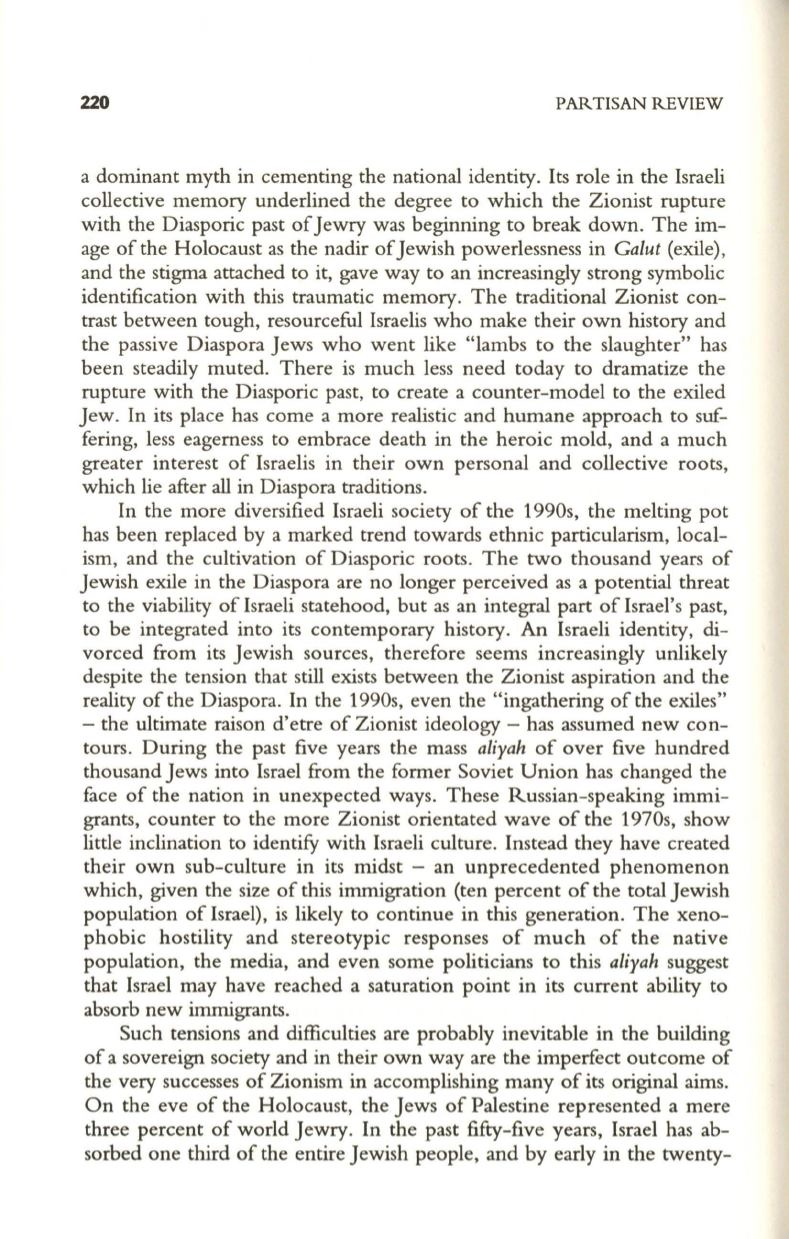
220
PARTISAN REVIEW
a dominant myth in cementing the national identity. Its role in the Israeli
collective memory underlined the degree to which the Zionist rupture
with the Diasporic past ofJewry was beginning to break down. The im–
age of the Holocaust as the nadir ofJewish powerlessness in
Galut
(
exile),
and the stigma attached to it, gave way to an increasingly strong symbolic
identification with this traumatic memory. The traditional Zionist con–
trast between tough, resourceful Israelis who make their own history and
the passive Diaspora Jews who went like "lambs to the slaughter" has
been steadily muted. There is much less need today to dramatize the
rupture with the Diasporic past, to create a counter-model to the exiled
Jew. In its place has come a more realistic and humane approach to suf–
fering, less eagerness to embrace death in the heroic mold, and a much
greater interest of Israelis in their own personal and collective roots,
which lie after
all
in Diaspora traditions.
In the more diversified Israeli society of the 1990s, the melting pot
has been replaced by a marked trend towards ethnic particularism, local–
ism, and the cultivation of Diasporic roots. The two thousand years of
Jewish exile in the Diaspora are no longer perceived as a potential threat
to the viability of Israeli statehood, but as an integral part of Israel's past,
to be integrated into its contemporary history. An Israeli identity, di–
vorced from its Jewish sources, therefore seems increasingly unlikely
despite the tension that still exists between the Zionist aspiration and the
reality of the Diaspora. In the 1990s, even the "ingathering of the exiles"
- the ultimate raison d' etre of Zionist ideology - has assumed new con–
tours. During the past five years the mass
aliyah
of over five hundred
thousand Jews into Israel from the former Soviet Union has changed the
face of the nation in unexpected ways. These Russian-speaking immi–
grants, counter to the more Zionist orientated wave of the 1970s, show
little inclination to identify with Israeli culture. Instead they have created
their own sub-culture in its midst - an unprecedented phenomenon
which, given the size of this immigration (ten percent of the total Jewish
population of Israel), is likely to continue in this generation. The xeno–
phobic hostility and stereotypic responses of much of the native
population, the media, and even some politicians to this
aliyah
suggest
that Israel may have reached a saturation point in its current ability to
absorb new immigrants.
Such tensions and difficulties are probably inevitable in the building
of a sovereign society and in their own way are the imperfect outcome of
the very successes of Zionism in accomplishing many of its original aims.
On the eve of the Holocaust, the Jews of Palestine represented a mere
three percent of world Jewry. In the past fifty-five years, Israel has ab–
sorbed one third of the entire Jewish people, and by early in the twenty-


